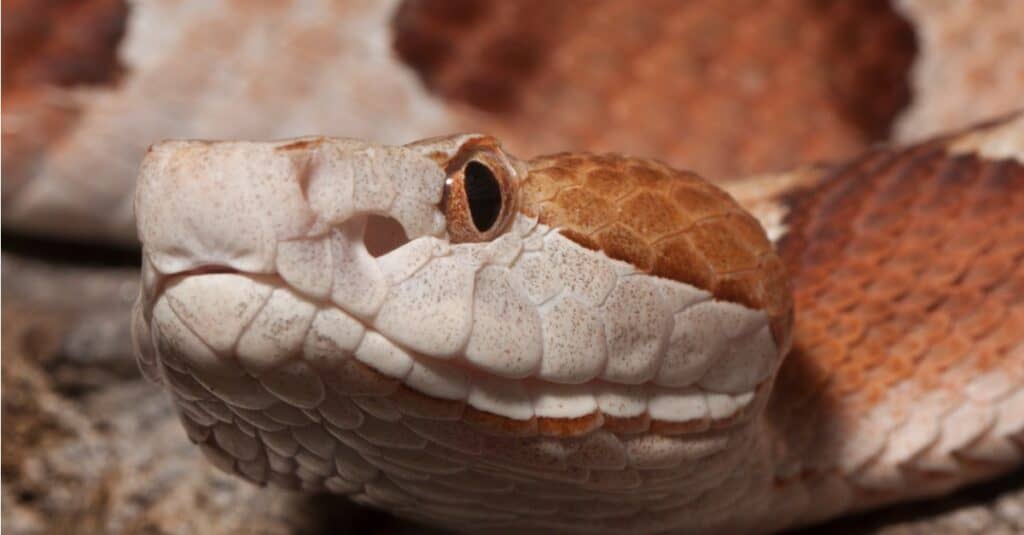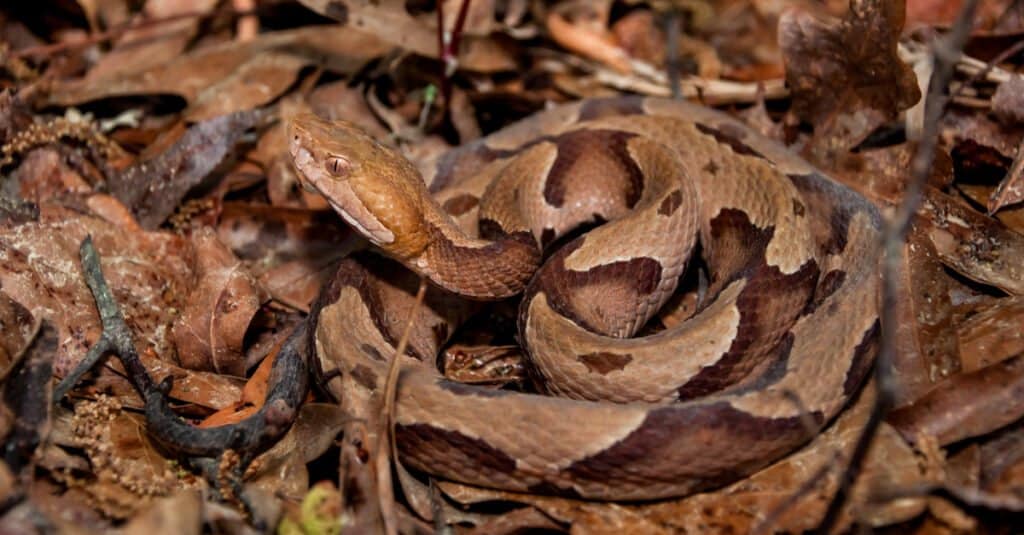Copperhead snakes are venomous carnivores that can grow up to 4 feet long. Their heads are copper-colored, which is where they got their name. They can be found in the southern and eastern United States.
These snakes belong to a group of snakes called pit vipers which means that they have heat-sensing pits between their nostril and eye. It’s a special organ that allows them to “see” the body heat of their prey.
Copperheads have cat-eye pupils, but you may not always see the shape because, like all pupils, they expand and contract to allow the right amount of light into the eye. Aside from that, not all venomous snakes have vertical pupils, and not all harmless snakes have round ones.
Pit vipers are the most evolved kind of snake, which means they’re the newest to have developed on the planet. Copperhead snakes primarily live in woodlands and forests.
What are some mind-blowing facts about copperhead snakes? Keep reading to find out!

1. Copperhead Snake Venom May Cure Cancer
In experiments on mice, it was shown that some properties of copperhead snake venom helped to shrink a cancerous tumor associated with ovarian cancer in humans. Another trial found that it may help shrink the size of metastatic breast cancer tumors in mice.
This is promising for the development of better tools to help cure cancer.
2. Copperhead Snakes: The Most Venomous Bites In the USA

Copperhead snakes often bite, though it is hardly fatal.
©iStock.com/Mark Kostich
Copperhead snakes are responsible for most of the venomous snake bites in the United States. If provoked, they’ll defend themselves, but they aren’t looking for a fight. According to some people who work with them, these are some of the calmer pit vipers.
Around 3,000 people are bitten by copperhead snakes in a year, though it is hardly fatal. Antivenom is available, but symptoms often resolve by themselves. But, that doesn’t mean there can’t be significant localized symptoms.
3. Eastern Equine Encephalitis and Copperhead Snakes
It’s believed that the eastern equine encephalitis virus might hide out in copperhead snakes over the winter outside of its main radius in Florida. This virus mainly transmits through mosquitos, killing 30% of the people it infects. However, it only infects ten Americans per year.
Mosquitos don’t bite snakes like they do people; they bite through the snake’s eye. Mosquitos can also bite people on their eyeballs, so it’s no surprise they also torment snakes in this way.
The virus takes about 4-10 days to cause symptoms, including a high fever and encephalitis or meningitis. If the patient is part of the unlucky one-third that succumb to their illness, death usually occurs 2 to 10 days after symptoms start, though some die of long-term complications a few years later.
4. Antivenom for Copperhead Snake Bites Isn’t Always Necessary
Most treatment protocols involve watching and waiting before administering antivenom. Doctors want to see that the bite was indeed an envenomation and severe enough to need it.
That said, some are pushing for antivenom in all envenomations. Why? Because administered early enough, it prevents the worst of the damage and can return bite victims to full health much faster.
While it’s true that some people might have an allergic reaction to antivenom, it’s rare and treatable. Most people who experience anaphylaxis with antivenom already know they have some form of preexisting allergy.
5. Female Copperhead Snakes: No Male Needed For Reproduction

Female copperheads can reproduce asexually in a process called parthenogenesis.
©Creeping Things/Shutterstock.com
In a process called parthenogenesis, female copperheads can give birth without mating. This usually happens when a female hasn’t encountered a male in a while. The babies generally don’t make it to their birth in quantities produced during sexual reproduction.
Parthenogenesis happens mostly in captivity, though a few studies show it infrequently occurs in the wild.
6. Copperhead Snake Females Have Eggs Hatch Inside Them
Copperhead snakes are ovoviviparous, meaning their babies develop inside their bodies and are born after a gestation period. This gestation period is roughly the same as the amount of time it would take if the female laid eggs and then incubated them. The only difference is that it’s happening inside the mother so she can protect them until they’re ready to be on their own. The babies are born alive and completely independent.
7. Opossums and Kingsnakes Are Immune to Copperhead Venom
Opossums will take on copperhead snakes for a meal, and that’s because they’re immune to their venom. Something blocks the snake venom molecules from being able to communicate with their bodies, so they survive even if they’re struck.
Kingsnakes make other snakes a part of their diet about 30% of the time, and copperheads are on the menu. They have enzymes in their body that break venom down.
8. Hibernation: Copperheads Snuggle Up With Other Snakes

Copperhead snakes sometimes hibernate with other kinds of snakes.
©Jay Ondreicka/Shutterstock.com
Although it’s called brumating when you’re talking about reptiles, it’s a similar idea: the snake finds a comfy spot to pass the coldest part of the year until it’s again warm enough to be out and about.
Sometimes, copperheads share burrows or hideouts with rattlesnakes and rat snakes. It’s common for many snake species to brumate with other kinds of snakes. Staying warm is the focus, not eating each other.
Copperheads that live in warm climates may not brumate, or may only do so for a few weeks.
9. Copperheads Climb for Cicadas
Cicadas make their appearance around mid-late-May in many regions. The sound of summer for many people, they’re also food for many animals including copperheads.
Because of the timing, some people believe that cicadas are a signal that copperheads are also out roaming. But that’s not exactly true. By the time cicadas emerge in most areas, copperheads have already been active for a month or more. Like all snakes, they follow the food — in this case, cicadas.
However, copperheads won’t eat just any cicada. It has to have just the right consistency. The freshly molted consistency. Since freshly molted cicadas are usually in the trees, you may find copperheads climbing for them.
10. A Copperhead’s Musk Smells Like Cucumbers
When a copperhead is threatened, it emits a musk that smells vaguely like cucumbers, though it’s mixed with feces as well, so the smells are not identical. Some say it smells more like melons.
When snakes release musk, it comes out of their cloaca — the same orifice used for feces, urine, reproduction, and musk. This makes it not uncommon for defecation to join the party.
Just because you’re able to smell a snake that’s released some musk doesn’t mean the snake will be able to reach you for an attack. That’s why it’s used as a warning signal.
The photo featured at the top of this post is © Breck P. Kent/Shutterstock.com
Discover the "Monster" Snake 5X Bigger than an Anaconda
Every day A-Z Animals sends out some of the most incredible facts in the world from our free newsletter. Want to discover the 10 most beautiful snakes in the world, a "snake island" where you're never more than 3 feet from danger, or a "monster" snake 5X larger than an anaconda? Then sign up right now and you'll start receiving our daily newsletter absolutely free.
Thank you for reading! Have some feedback for us? Contact the AZ Animals editorial team.






